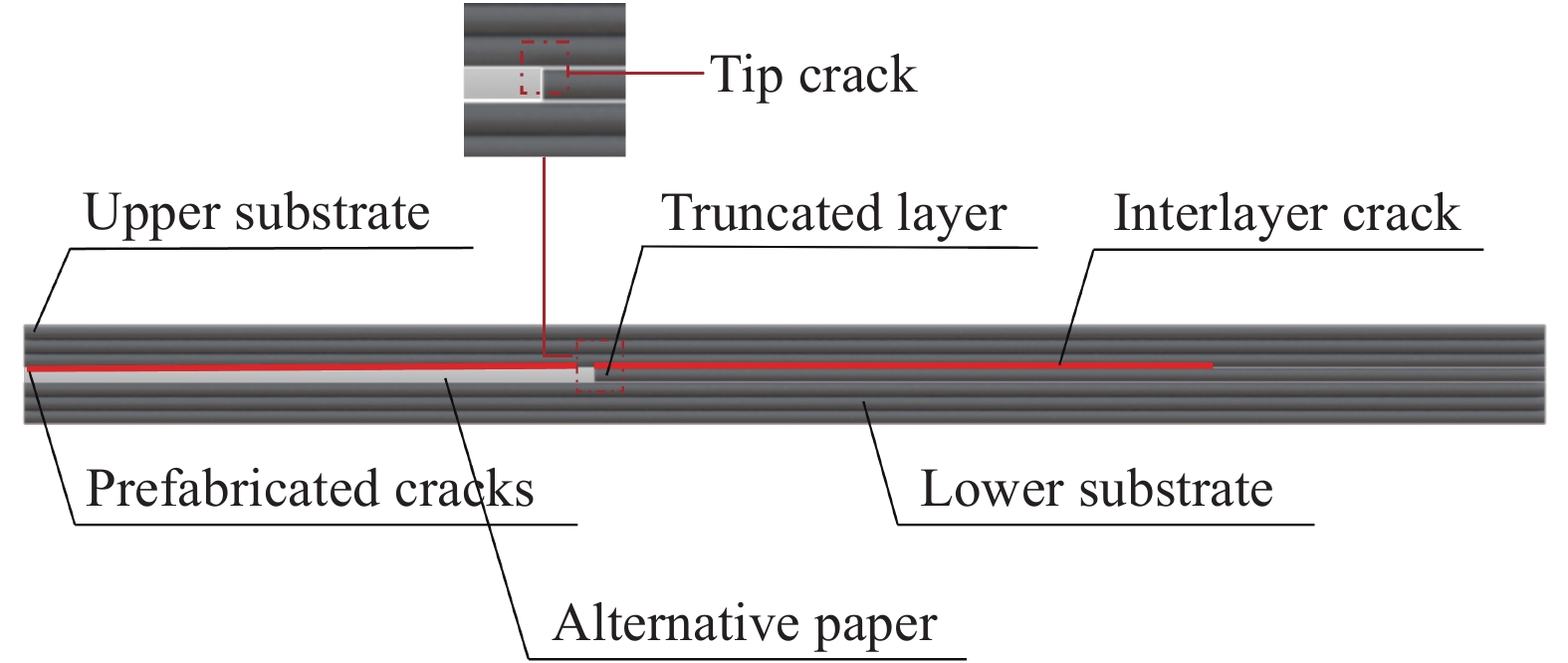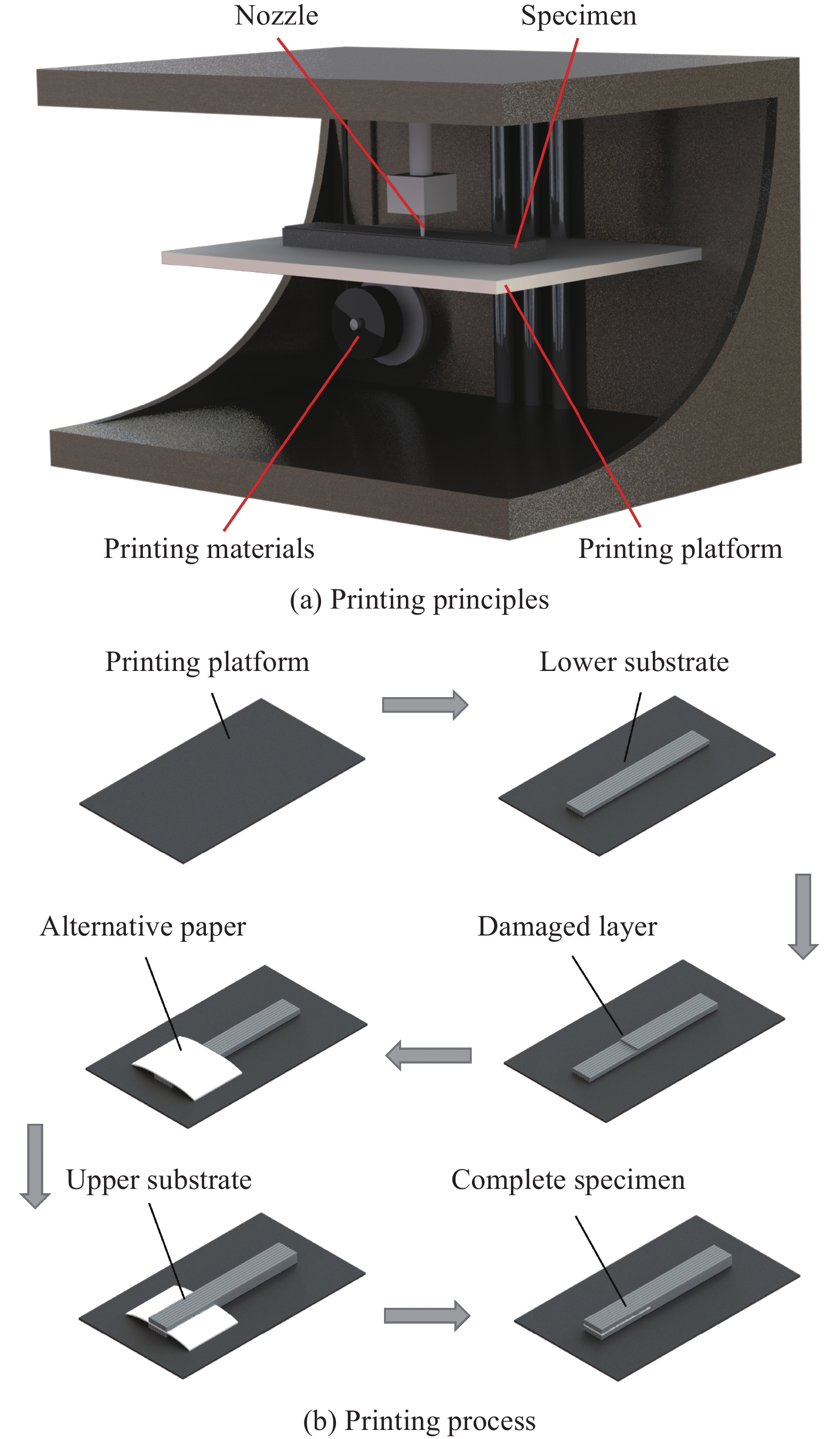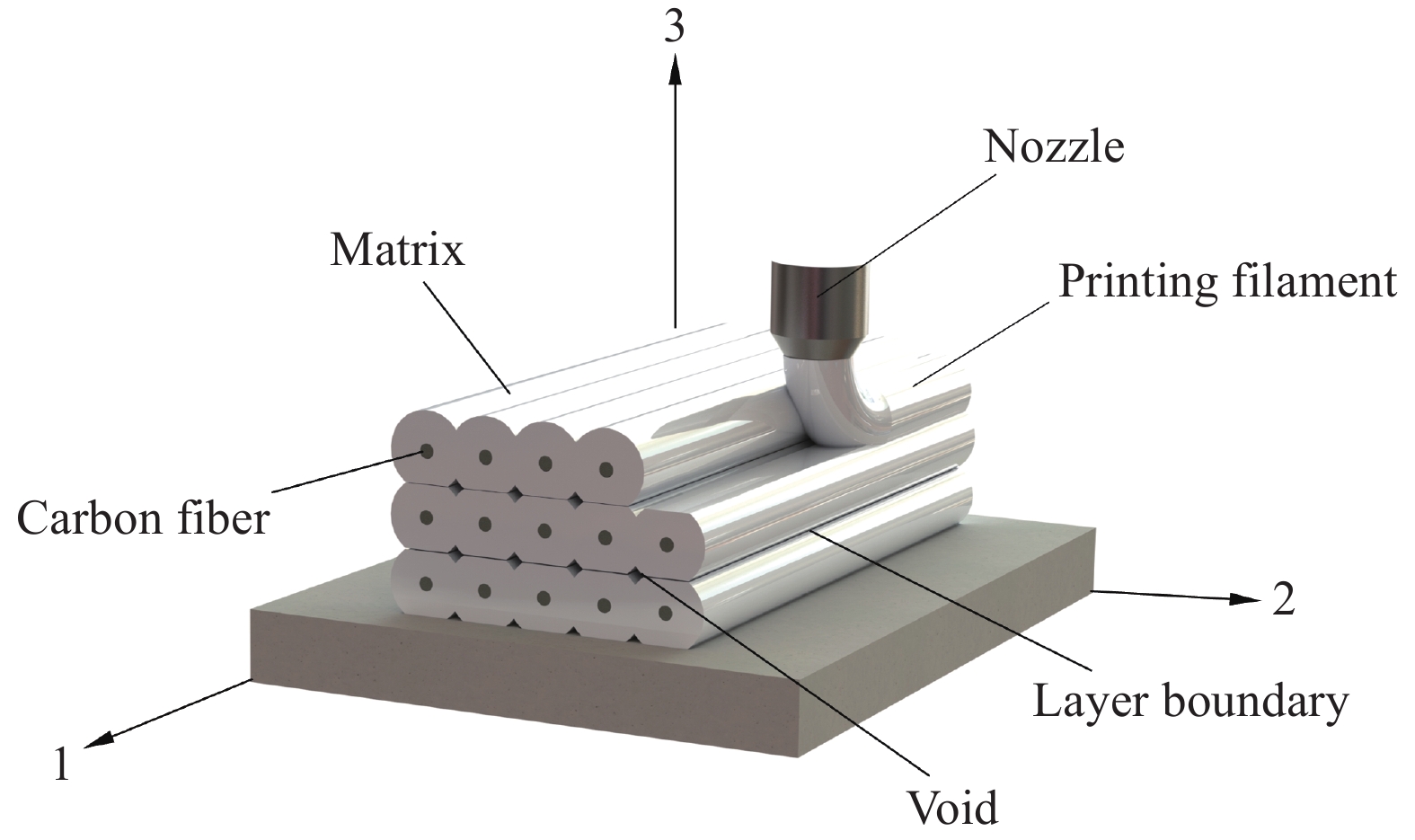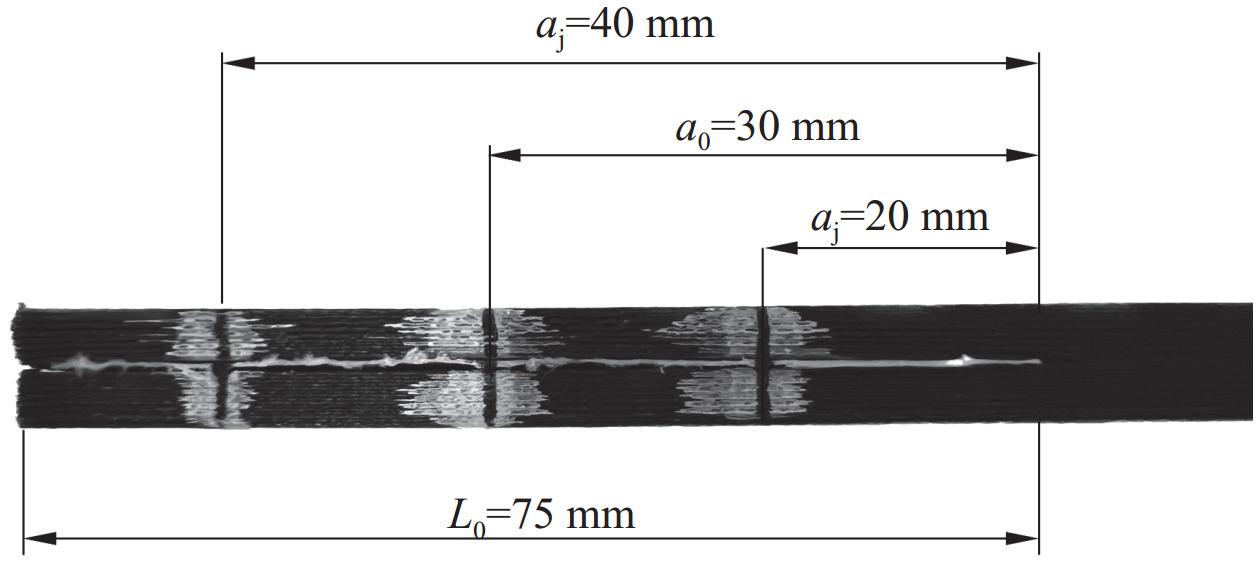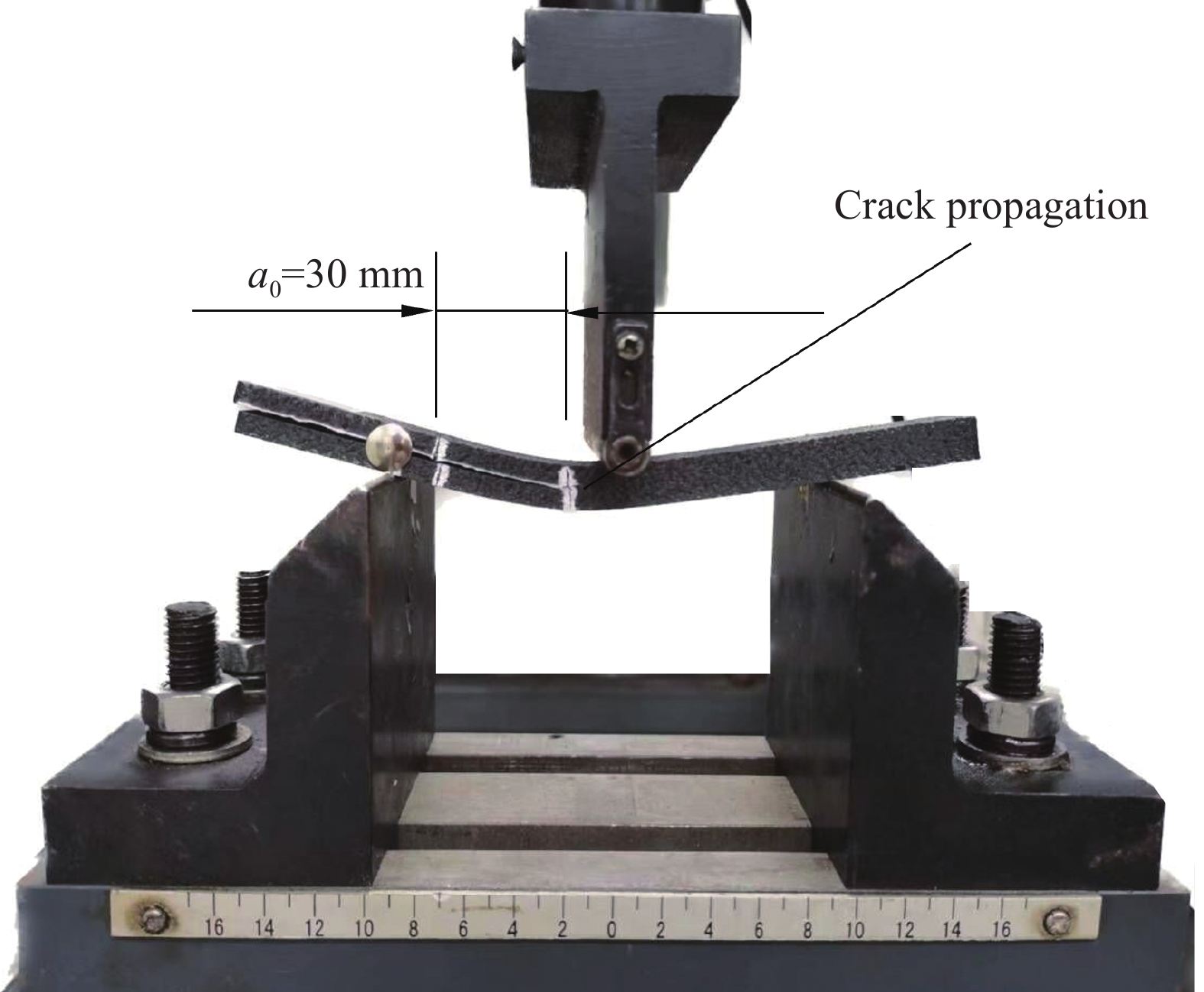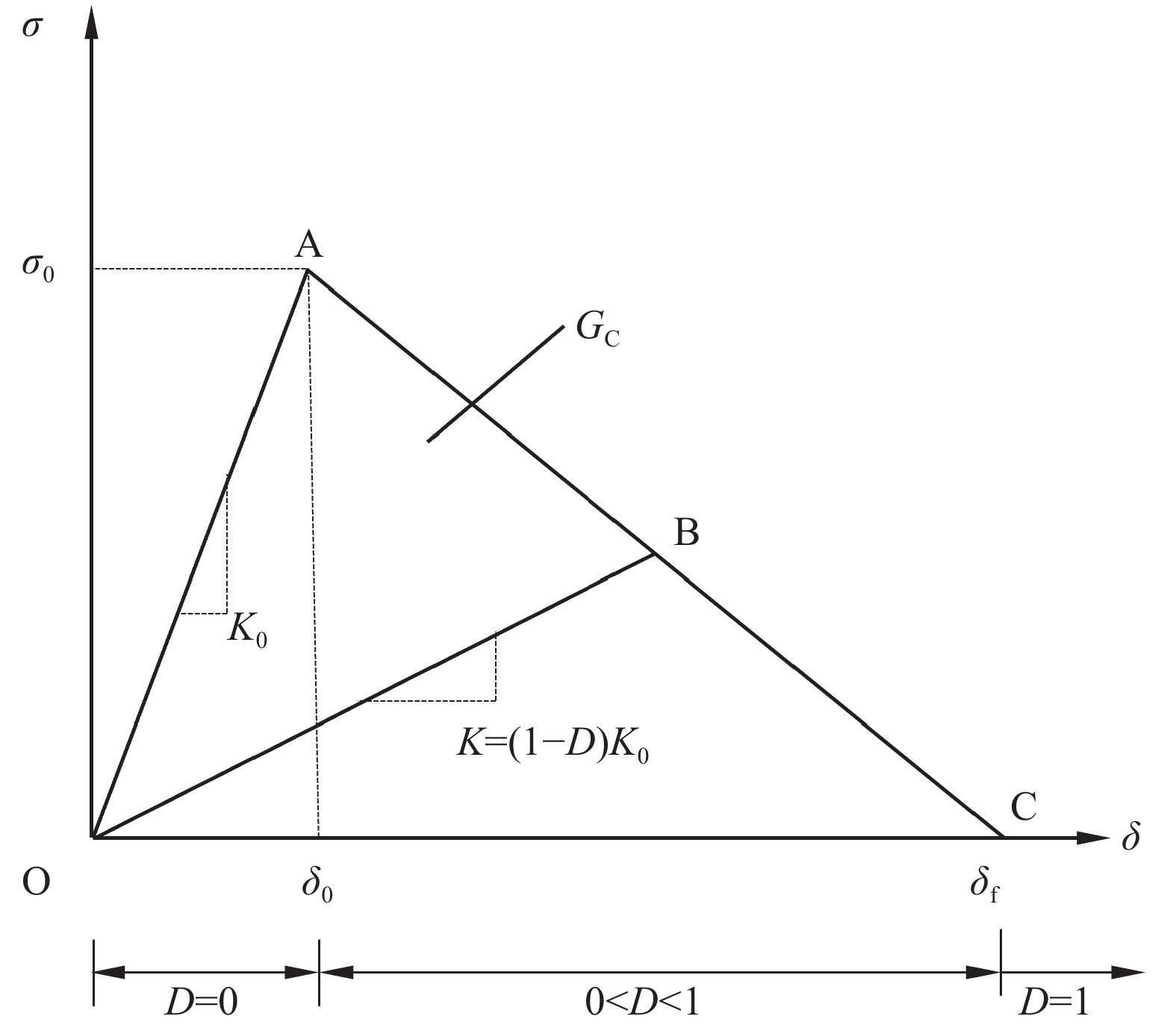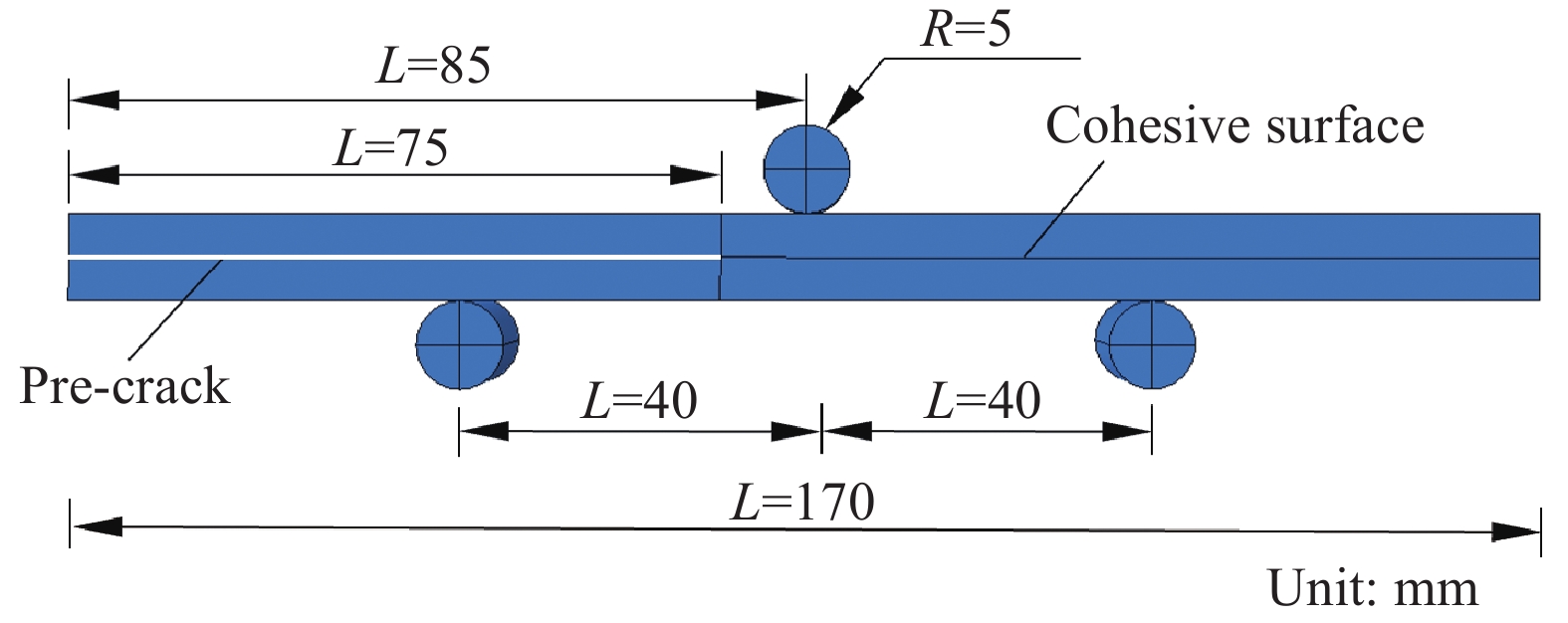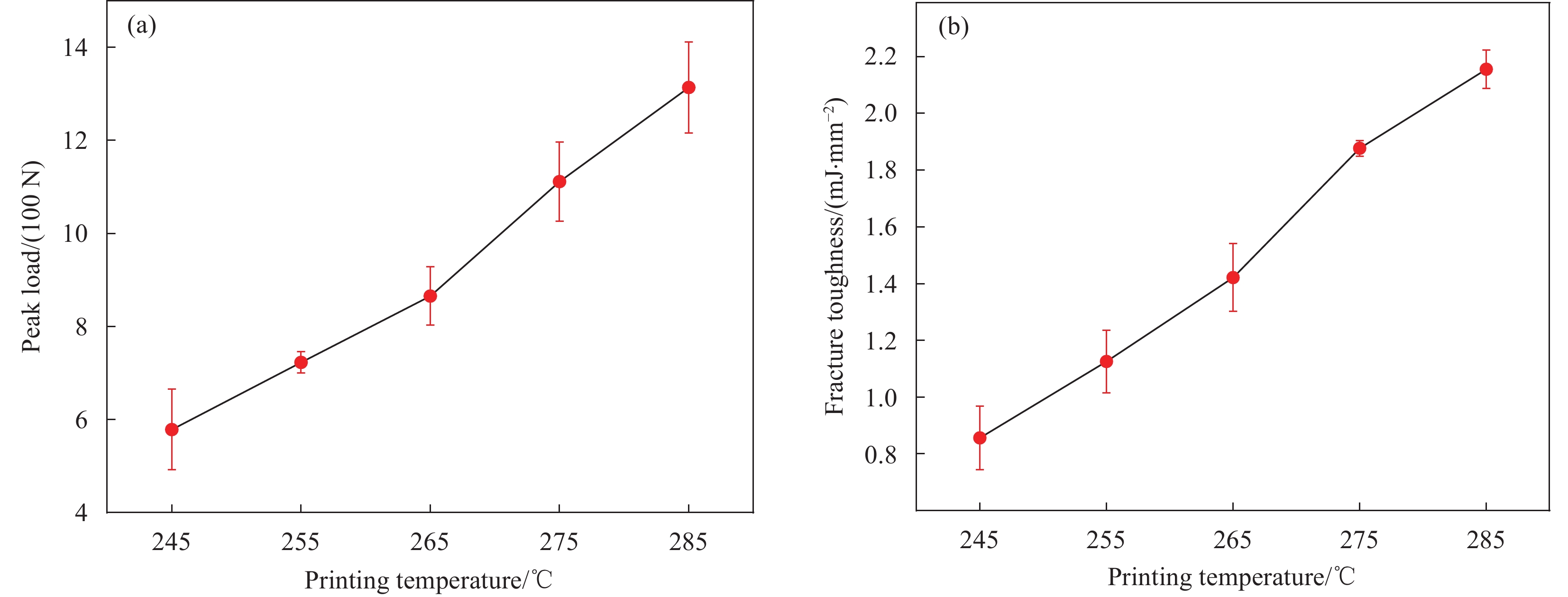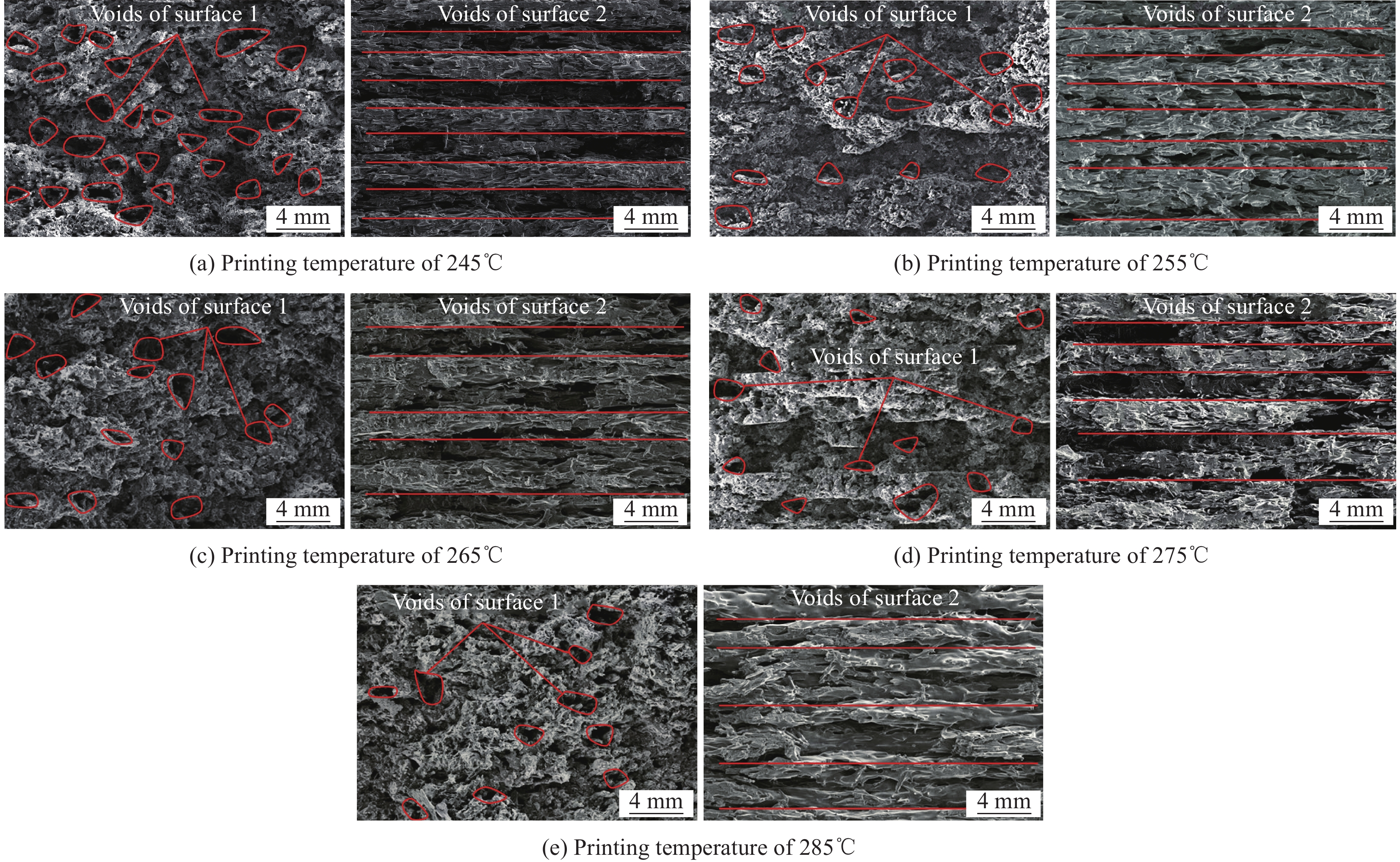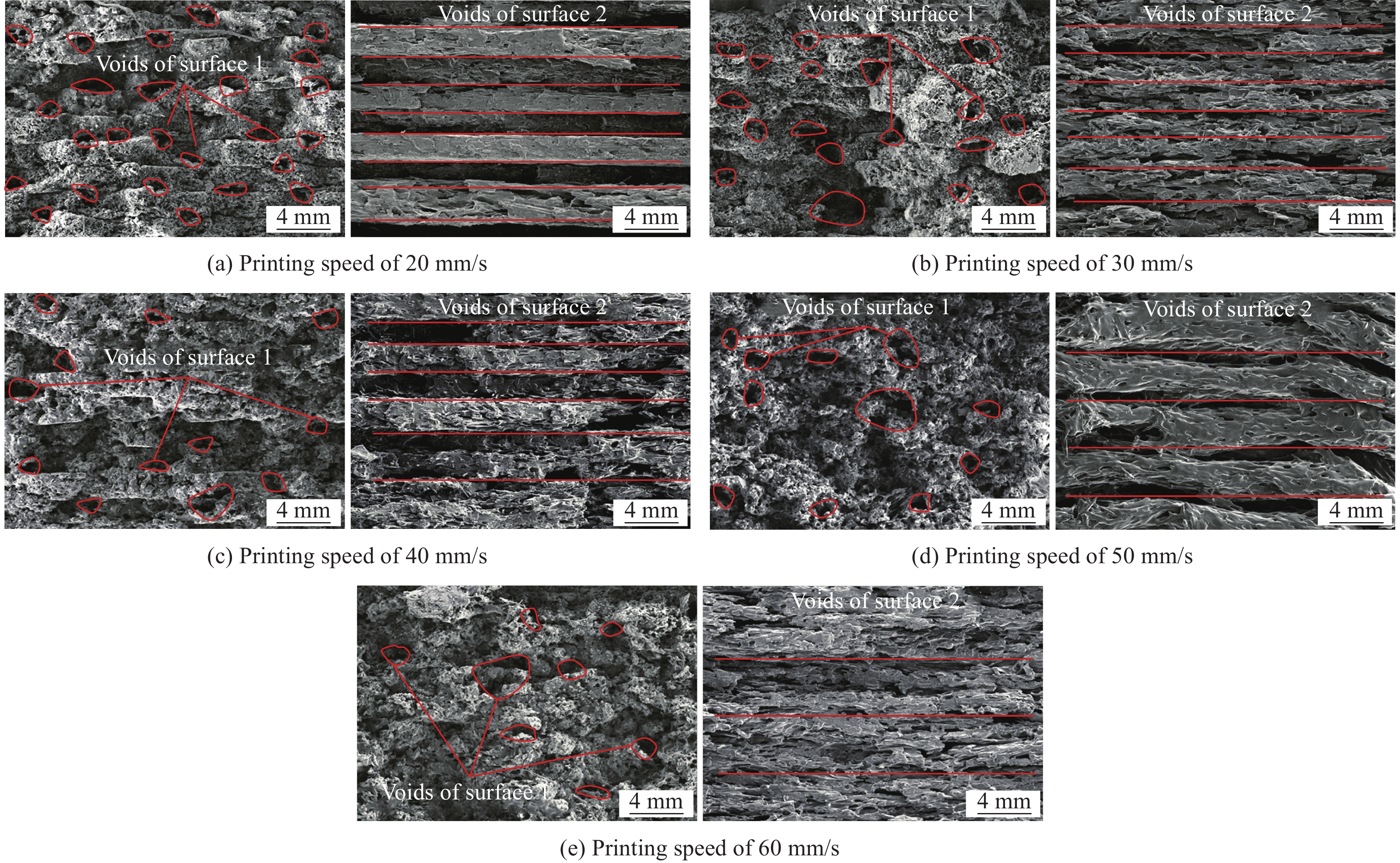Missing layer replacement method and parameterized analysis of mode II inter-layer fracture toughness of additive manufacturing CFRP
-
摘要:
为实现增材制造碳纤维增强树脂基复合材料(Carbon fiber reinforced polymer,CFRP)-II型层间断裂韧性的测试分析,并量化打印参数对II型层间断裂韧性的影响规律,推进增材制造CFRP技术在桥梁结构中的应用,本文分别从试验及仿真分析两方面展开了相关研究。首先,对打印工艺进行优化并提出了一种新型层间预制裂纹制备方法,即缺层置换法,并利用该方法探索了两类关键打印参数(打印温度、打印速度)对增材制造CFRP-II型层间断裂韧性的影响规律。其次,基于内聚区理论建立了不同打印工况下预制裂纹试件端部缺口梁三点弯曲(End notched flexure,ENF)试验的仿真模型,并完成了仿真结果与试验数据的对比分析。结果表明:两类关键打印参数对增材制造CFRP-II型层间断裂韧性的影响明显,且打印温度的影响更强。当打印温度从245℃提升至285℃,试验荷载峰值的变化幅度范围为18%~27%,层间断裂韧性的变化幅度范围为14%~32%;当打印速度从20 mm/s提升至60 mm/s,试验荷载峰值的变化幅度范围为4%~31%,层间断裂韧性的变化幅度范围为4%~16%。同时,仿真结果与试验数据的相对误差均控制在10%以内,表明本次所获试验数据合理且稳定,故缺层置换法可用于制备增材制造CFRP预制裂纹试件,且传统工艺复合材料仿真方法同样适用于增材制造CFRP的仿真分析。因此,本文可为后续增材制造CFRP桥梁结构层间力学性能的量化分析提供技术支撑。
Abstract:In order to test and analyze the mode II inter-layer fracture toughness of additive manufacturing carbon fiber reinforced polymer (CFRP), and quantitatively evaluate the influence of printing parameters on the mode II fracture toughness, then promote the application of additive manufacturing CFRP technology in bridge structure, experimental and simulation methods were used to carry out the relevant explorations, during this study. Firstly, the printing process was optimized and a novel method for preparing inter-layer pre-cracks was proposed, namely missing layer replacement method. Meanwhile, the influence of two types of key printing parameters (Printing temperature and printing speed) on the mode II inter-layer fracture toughness of additive manufacturing CFRP was studied. Secondly, based on the cohesive zone theory, simulation models of the end notched flexure (ENF) test specimens with pre-cracks under various printing conditions were established. In addition, a comparative analysis between simulation results and test data was carried out. The results indicate that the influence of two key printing parameters on the mode II inter-layer fracture toughness of additive manufacturing CFRP are significant, and the influence of printing temperature is stronger. When the printing temperature increases from 245℃ to 285℃, the variation range of peak force test data is 18%-27%, and the variation range of inter-layer fracture toughness is 14%-32%. When the speed increases from 20 mm/s to 60 mm/s, the variation range of peak force test data is 4%-31%, and the variation range of inter-layer fracture toughness is 4%-16%. Moreover, the relative errors between simulation results and test data are controlled within 10%, which indicates that the test data in this study is reasonable and stable, so the missing layer replacement method has strong practicality for preparing additive manufacturing CFRP specimens with pre-cracks. In addition, the simulation method of traditional process composites is also suitable for the simulation analysis of additive manufacturing CFRP. Therefore, this method can provide technical support for the subsequent quantitative evaluation of inter-layer mechanical properties of additive manufacturing CFRP bridge structures.
-
碳纤维增强树脂基复合材料(Carbon fiber reinforced polymer,CFRP)具有高比强度/刚度、耐腐蚀及抗疲劳等优势,已被广泛应用于土木工程、航空航天及轨道交通等领域[1-5]。然而,传统设计制造工艺灵活性较低,导致该技术的大范围推广受限。增材制造CFRP技术的出现为解决上述设计制造问题提供了全新思路。然而,由于层积成型工艺的特殊性及材料自身的结构性,导致增材制造CFRP材料易发生分层损伤,对该项技术的推广有较大影响[6]。为探明增材制造CFRP的层间力学性能,国内外学者展开了系列研究。
Liu等[7-8]通过改变碳纤维束外层环氧树脂施胶层及在增材制造工艺中采用上浆工艺,系统地研究了上浆与打印工艺对界面性能及断裂模式的影响,同时采用微螺杆原位挤压法制备了增材制造连续碳纤维增强尼龙基复合材料,实现了复合材料制备-成型一体化,且具有较高的纤维含量及良好的力学性能;Tian等[9]通过将连续碳纤维与聚乳酸混合,实现了碳纤维增强热塑性复合材料的一体化制备及成型,通过改变工艺参数分析了增材制造复合材料的界面性能;Luo等[10-11]通过调节基体材料黏度及实施预浸渍,对不同激光预热温度下的层间键合行为进行了研究,并有效实现了连续碳纤维增强聚醚醚酮复合材料充分浸渍和层间键合的改善,同时,利用等离子体-激光协同辅助增材制造工艺改善双尺度界面,通过对失效模式和双尺度界面键合机制的分析,发现激光主要改善层间键合和结晶度,而等离子体则有效提高了碳纤维的力学模量;上述学者仅从增材制造工艺及设备优化方面进行研究,缺乏细观角度及参数化的界面力学性能分析。Iragi等[12]对增材制造CFRP层合板进行了层内及层间力学性能的研究,确定了层内弹性、强度性能及界面强度和断裂特性,并分析了层积成型工艺缺陷对这些特性的影响规律;Caminero等[13]通过改变打印层厚及纤维体积含量,探明了这两类参数对增材制造连续碳纤维、玻璃纤维及凯夫拉纤维增强尼龙基复合材料层间粘合性能的影响;Yavas等[14]通过短梁剪切试验,量化评价了连续碳纤维及短碳纤维两种增强材料对增材制造CFRP层间剪切性能的影响;Somireddy等[15]对不同层厚及打印方向增材制造层合板的力学性能进行了测试分析,表明薄层打印件的层内拉伸性能优于厚层打印件,但厚层打印件的层间性能优于薄层打印件,并准确地预测了薄层双向打印部件的力学行为;Kong等[16]从纯I、II模式下的层间断裂特征及混合模式下的界面破坏机制两方面对增材制造CFRP的界面质量进行研究,结果表明不同纤维取向的界面特征完全不同;Cai等[17]研究了打印参数(挤出流速、打印温度、打印层厚及打印速度)对增材制造连续苎麻纤维增强聚丙烯复合材料界面性能的影响,表明界面强度较弱的打印试样在弯曲载荷作用下会发生脱层破坏,大大削弱了复合材料的综合力学性能;Touchard等[18]通过拉伸试验与双悬臂梁试验从层内与层间两个方面研究了增材制造CFRP的界面力学性能,并最终给出了不同铺设角度材料的界面力学性能;Dang等[19]研究了碳纤维及凯夫拉纤维两种不同增强材料的增材制造层合板层间断裂韧性,表明增材制造产生的孔洞缺陷严重影响了碳纤维层合板的层间断裂韧性,而凯夫拉纤维层合板的层间结合更好,可以显著提高层间断裂韧性;上述学者仅从定性试验角度研究了制备参数对增材制造树脂基复合材料层间力学性能的影响规律,未形成量化结论。
综上所述,针对增材制造CFRP层间力学性能的相关研究已经广泛展开,但基本还停留在定性分析各类打印参数对材料层间力学性能的影响趋势方面。具体存在以下两点不足:①针对增材制造CFRP材料,缺少适用的层间预制裂纹制备方法,传统工艺复合材料制备预制裂纹法由于薄膜有一定厚度会阻挡打印喷头路径,不适用于增材制造CFRP技术;②尚未对层间力学性能的影响因素展开较系统的量化分析。
本文提出了一种新方法,能高效制备增材制造CFRP (短切碳纤维含量为25wt%)层间预制裂纹试件,即缺层置换法。通过此方法量化分析了两类关键打印参数(打印温度、打印速度)对II型层间力学性能(荷载峰值、峰值力位移、II型层间断裂韧性)的影响规律,并基于内聚区理论建立了预制裂纹试件端部缺口梁三点弯曲(End notched flexure,ENF)试验仿真模型,该模型参考了传统工艺复合材料的建模思路,将试验得到的II型层间断裂韧性作为关键仿真参数,所获荷载-位移仿真曲线与试验曲线对比误差不超过10%。表明了缺层置换法在层间预制裂纹试件制备与试验数据获取方面的合理性及有效性,同时证明了传统工艺复合材料仿真方法可用于增材制造CFRP的仿真分析,为增材制造CFRP的仿真方法做出了探索性工作。
1. 增材制造CFRP试验及数据处理
1.1 增材制造CFRP材料性能及试件制备过程
1.1.1 材料物理性能
本文采用的材料为碳纤维增强尼龙基复合材料(CF/PA6),其组分材料尼龙及碳纤维均为工程领域力学性能优异的材料,其中碳纤维的含量为25wt%,打印原材料相关物理性能见表1[20-22]。
表 1 增材制造碳纤维增强树脂基复合材料(CFRP)的物理性能Table 1. Physical properties of additive manufacturing carbon fiber reinforced polymer (CFRP)Test condition Property Value ASTM D792[20] Density/(g·cm−3) 1.17 DSC[21], 10℃/min Vitrification temperature/℃ 56.6 300℃, 2.16 kg Melt index/(g·min−1) 205 DSC[21], 10℃/min Melting point/℃ 220 DSC[21], 10℃/min Crystallization temperature/℃ 186.6 ISO 75[22], 1.8 MPa Thermal deformation/℃ 196 Note: DSC—Differential scanning calorimetry. 1.1.2 试件几何特征
本次基于美国规范ASTM D7905[23]的ENF试验测定增材制造CFRP的II型层间断裂韧性,所用试件为具有预制裂纹的立方体薄板。如图1所示,试件在厚度方向分为三部分,从上至下分别为上基板、损伤层及下基板。按构造分为上基板、缺失层(替代纸)、被截层(有粘结段)及下基板四部分,其中损伤层由替代纸与被截层组成且紧密结合,预制裂纹位于上基板与替代纸结合处,尖端裂纹位于上基板与被截层结合处,层间裂纹位于上基板与被截层相互结合位置及裂纹沿此处扩展。试件尺寸为170 mm×20 mm×10.2 mm,预制裂纹长度为75 mm,上基板与下基板厚度均为5 mm,损伤层厚度为0.2 mm,如图2所示。
1.1.3 试件制备方法
试件长度方向为增材制造CFRP丝材铺设方向,宽度方向由若干丝材按一定的重叠率并排铺设组成,厚度方向由铺层按一定的层厚堆叠而成。本次所用3D打印机由RAISE 3D提供,试件打印参数在表2及表3中给出,每种打印工况制备3个试件。
表 2 增材制造CFRP固定打印参数Table 2. Fixed printing parameters of additive manufacturing CFRPParameter Value Layer height/mm 0.2 Heated build platform temperature/℃ 90 Filling rate/% 99 Filling shape Linear Filling overlap rate/% 5 Nozzle diameter/mm 0.4 表 3 增材制造CFRP变量打印参数Table 3. Variable printing parameters of additive manufacturing CFRPTemperature/℃ Speed/(mm·s–1) 245, 255, 265, 275, 285 20, 30, 40, 50, 60 本次提出的新型预制裂纹试件制备方法为缺层置换法,具体流程如下:
①首先,设置打印参数并将试件的三维模型按照打印路径规划生成切片模型,将切片模型对应的机器控制代码输入至3D打印机平台,同时设置打印进程至被截层打印完成后自动暂停;
②其次,打印前在底板材料附着区域涂胶。当底板、下基板、被截层打印完成后打印暂定,并在缺失层处铺设无粘结非光滑替代纸,铺设时间控制在10 s内。替代纸宽为73.5 mm (替代纸宽度应略小于预制裂纹长度,以1~3 mm为宜),厚度为0.2 mm (替代纸厚度应与被截层厚度一致以保证裂纹前缘不会出现钝的尖端裂纹);
③最后,替代纸铺设完成后立刻恢复打印进程继续打印上基板至全部打印结束。打印完成后,将试件与底板分离,再将多余的替代纸去除,整个试件即完成打印。试件打印原理如图3所示。
1.1.4 材料细观结构
本次通过扫描电子显微镜(SEM,Sigma360, ZEISS公司)获取了增材制造CFRP试件横截面的细观结构,包括垂直于打印丝方向的面1及平行于打印丝方向的面2,CFRP的细观结构在图4中给出。进一步,材料细观结构的三维几何模型在图5中给出。
增材制造CFRP技术的原理是将高温熔融材料通过圆形喷嘴挤出,打印丝按照一定路径铺设从而完成打印。在铺设过程中打印丝底部因接触到已固化材料时发生塑性流动而变得扁平。同时,受打印速度、打印温度等参数的影响,无论是层间还是层内,打印丝之间都无法完全融合,垂直于打印丝方向的断面会出现形状不规则的孔洞,平行于打印丝方向的断面会出现明显的分层界限,如图4所示。因此,增材制造CFRP试件的层间力学性能较薄弱。
1.2 增材制造CFRP试验过程
1.2.1 测试设备
本次采用的测试设备包括:电子万能试验机(三思纵横UTM-6503)、配套三点弯曲夹具(夹具的加载辊子半径为5 mm,硬度满足HRC 55)及电子显微镜。本次试验加载速率2 mm/s,万能试验机加载速率为0.025~2.6 mm/s,采样频率为5 Hz。
1.2.2 试验准备阶段
加载前用白色喷漆在试件侧边预制裂纹处进行喷涂,喷漆凝固后从预制裂纹内侧端部开始以20 mm、30 mm、40 mm的距离用0.5 mm机械铅笔绘成垂直铅笔线标记3个符合性校准位置,如图6所示。
1.2.3 试验加载阶段
首先,II型层间断裂试验开始前需要完成两次柔度校准,分别取分层长度为20 mm、40 mm的两点进行三点弯曲柔度校准试验[23],得到两组载荷-位移曲线并计算出两组柔度C。为保证柔度校准时试件内部不产生微裂纹,加载力需要控制在一定范围内。柔度校准力根据下式确定:
Pj=2B3aj√GIICE1fh3 (1) 其中:Pj为柔度校准力;B为试样宽度;GIIC为层间断裂韧性的经验预估值;aj为柔度校准法的分层长度;E1f为试件弯曲模量;h为试件厚度的1/2。
其次,将试件重新定位至初始裂纹长度a0=30 mm处进行II型层间断裂韧性测试,并记录相关数据,试件加载示意见图7,试验过程见图8及图9。
1.3 评价指标
本次采用的II型层间断裂韧性作为评价指标,数据处理方法为基于柔度标定的CC1方法[24],其理论来源为能量释放率:
G=P22BdCda (2) 其中:P为ENF试验中的载荷;a为分层长度。
基于材料力学理论确定柔度C的表示形式为
C=2L3+3a38E1fBh3 (3) 其中,L为试件长度。
根据式(3)可知柔度C为a3的线性函数,因此柔度C与分层长度a之间的关系可表示为[25]
C=A+ma3 (4) 其中,A与m为拟合参数。
将式(4)带入式(2)得GII的计算式如下:
GII=3ma2p22B (5) 其中,当p取为II型分层扩展对应的载荷p0时,计算得到的GII值即为II型层间断裂韧性GIIC,GIIC为剪切应力作用下单位界面破坏时的能量释放量。
2. 增材制造CFRP-II型分层失效的仿真分析
2.1 分析理论
2.1.1 内聚区模型
内聚区模型(Cohesive zone model,CZM)广泛应用于各类界面失效分析中,是研究复合材料分层问题的一种重要方法[26-27]。双线性本构关系是内聚区模型中最常用的本构关系,具体形式如图10所示。
![]() 图 10 内聚区双线性本构模型σ—Stress; δ—Displacement; σ0—Layered damage initiation stress; δ0—Initial displacement of delamination damage; δf—Displacement corresponding to complete layering of materials; K0—Initial interface stiffness; K—Damage interface stiffness; D—Damage variable; GC—Fracture toughnessFigure 10. Bilinear constitutive model of cohesive zone
图 10 内聚区双线性本构模型σ—Stress; δ—Displacement; σ0—Layered damage initiation stress; δ0—Initial displacement of delamination damage; δf—Displacement corresponding to complete layering of materials; K0—Initial interface stiffness; K—Damage interface stiffness; D—Damage variable; GC—Fracture toughnessFigure 10. Bilinear constitutive model of cohesive zone双线性本构模型以分层损伤起始位移δ0为界限分为两段,第一段为材料层间力学性能的线弹性阶段,此时界面刚度K0保持不变。第二段为层间界面损伤阶段,当界面应力达到分层损伤起始应力σ0时,通过损伤变量D的增加来实现界面刚度退化。
双线性内聚力本构关系:
σi={K0δi(δi⩽ (6) 其中, {\delta _{\text{f}}} 为材料完全分层时对应的位移。
2.1.2 损伤起始判据与演化准则
本次使用的损伤起始判据是最大名义应力准则[26],该判据如下所示:
\left\{ \begin{gathered} \max \left( {\frac{{\left\langle {{\sigma _{\text{n}}}} \right\rangle }}{{\sigma _{\text{n}}^{\max }}},\frac{{{\sigma _{\text{s}}}}}{{\sigma _{\text{s}}^{\max }}},\frac{{{\sigma _{\text{t}}}}}{{\sigma _{\text{t}}^{\max }}}} \right) = 1 \\ \left\langle {{\sigma _{\text{n}}}} \right\rangle = \left\{ \begin{gathered} {\sigma _{\text{n}}},{\text{ }}{\sigma _{\text{n}}} \geqslant 0 \\ 0,{\text{ }}{\sigma _{\text{n}}} < 0 \\ \end{gathered} \right. \\ \end{gathered} \right. (7) 其中, {\sigma _{\text{n}}} 、 {\sigma _{\text{s}}} 、 {\sigma _{\text{t}}} 为层间界面上的3个应力分量,下标取s时为II型层间断裂工况,为方便表示后文符号下标取II来代替。
当式(7)中判据等于1时,假定损伤起始。本次损伤演化采用线性模式[27],对于线性软化,损伤变量 D 可表示为
D=\frac{{\delta }_{\text{II}}^{\text{f}}\text{(}{\delta }_{\text{II}}^{\text{max}}-{\delta }_{\text{II}}^{\text{0}}\text{)}}{{\delta }_{\text{II}}^{\text{max}}\text{(}{\delta }_{\text{II}}^{\text{f}}-{\delta }_{\text{II}}^{\text{0}}\text{)}} (8) 其中: {\delta }_{\text{II}}^{\mathrm{max}} 表示层间界面损伤演化过程中的有效位移最大值; {\delta }_{\text{II}}^{0} 表示层间界面损伤起始时的有效位移; {\delta }_{\text{II}}^{\text{f}} 表示层间界面完全失效时的有效位移。
该规律描述了内聚区模型刚度退化的过程。 D = 0 ,表示层间界面没有发生损伤,仍处于弹性状态。损伤开始后,刚度损伤因子 D 增加,直到 D = 1 时层间界面完全失效。
2.2 仿真模型
2.2.1 ENF试验建模参数
本次基于ABAQUS/Explicit完成增材制造CFRP预制裂纹试件ENF试验的相关仿真分析,模型如图11所示。模型由上基板、损伤层与下基板三部分构成,尺寸为170 mm×20 mm×10.2 mm。模型中的三点弯曲夹具采用刚体建模,半径为5 mm,长度为20 mm,模型中设置一个加载点及两个支点,加载点位于试件的中心点,支点位于距离试件中心40 mm处。
本文对大量文献进行总结[28-31],文献给出了复合材料界面刚度及强度的参考范围。同时,结合预试验与仿真分析,最终确定各工况下界面刚度 {K_0} 及界面强度 {\sigma _0} 的值并在表4中给出,界面能量为试验测得断裂韧性值。
2.2.2 接触属性
考虑到试验中夹具与试件之间的摩擦及加载点的位置变化,本文将夹具及试件分别设置为刚性体及变形体,两者间的接触属性为面面接触。同时,预制裂纹上、下基板间界面也设置为面面接触。该接触垂直方向设置为硬接触,水平方向设置为摩擦接触,摩擦系数设为0.3。在试件的被截层设置通用接触,同时设置粘结行为与损伤特征。
表 4 不同工况下的界面刚度 {K_0} 及界面强度 {\sigma _0}Table 4. Interface stiffness {K_0} and interface strength {\sigma _0} with different working conditionsPrinting
temperature/℃Printing speed/
(mm·s−1){K_0} /(MPa·mm−1) {\sigma _0} /MPa Printing
temperature/℃Printing speed/
(mm·s−1){K_0} /(MPa·mm−1) {\sigma _0} /MPa 245 40 1.8×103 16 275 20 1.7×103 17 255 2.6×103 19 30 2.4×103 21 265 2.7×103 22 50 3.3×103 26 275 3.0×103 24 60 3.7×103 28 285 3.3×103 28 2.2.3 边界条件与加载方式
关于仿真模型边界条件的设置,ENF试验模型的加载及边界条件只设置在刚性体夹具上,两个支点夹具设置为固结,即 {{{U}}_{\text{1}}}{\text{ = }}{{{U}}_{\text{2}}}{\text{ = }}{{{U}}_{\text{3}}}{\text{ = }}{{{U}}_{{\text{R1}}}}{\text{ = }} {{{U}}_{{\text{R2}}}}{\text{ = }}{{{U}}_{{\text{R3}}}}{\text{ = 0}} ,其中U为方向位移,UR为方向角。加载点夹具除y方向平动不为0,其他均设为固结,即 {{{U}}_{\text{1}}}{\text{ = }}{{{U}}_{\text{3}}}{\text{ = }}{{{U}}_{{\text{R1}}}}{\text{ = }}{{{U}}_{{\text{R2}}}}{\text{ = }}{{{U}}_{{\text{R3}}}}{\text{ = 0}} ,y方向存在加载位移,因此 {{{U}}_{\text{2}}} \ne {\text{0}} 。
2.2.4 网格敏感性分析
仿真中,单元尺寸直接影响到数值计算精度及计算时长。通常,当单元尺寸减小,计算精度会相应提高,但同时计算时长也会增加,因此在确定网格尺寸时应综合考虑精度及时长。本次以打印温度275℃、打印速度40 mm/s的ENF试验构件为例,将该实体模型全局单元尺寸分别划分为长度(L)=宽度(B)=4、3及2 mm,高度(H)=1.25 mm,如图12所示,并对比这3种单元尺寸下的模拟荷载-位移曲线。
表 5 不同网格尺寸下的计算用时及最大荷载对比Table 5. Comparisons of calculation time and maximum load with different mesh sizesMesh size/mm Number of units CPU calculation time/s Maximum load/N 4 3472 1218 1105.031 3 3640 1390 1111.864 2 7680 2334 1116.225 Note:CPU—Computer processor. 由图13、表5可知,随着网格尺寸减小,最大荷载趋于稳定,但网格尺寸为2 mm时所用计算时间是网格尺寸为3 mm时的2倍左右。因此,选择网格尺寸为3 mm时,既可保证计算精度又可保证计算效率。
3. 结果与讨论
3.1 试验结果与分析
3.1.1 打印温度对层间力学性能的影响
不同打印温度下ENF试件的荷载-位移曲线在图14中给出。基于试验数据,分别获得各组试件的层间力学性能值,如表6、表7及表8所示。并绘制出平均荷载峰值及平均断裂韧性变化曲线,如图15所示。
表 6 不同打印温度下试件荷载峰值Table 6. Peak loads of specimens with different printing temperaturesPeak load/N 245℃ 255℃ 265℃ 275℃ 285℃ Specimen I 674.043 736.153 853.720 1083.141 1211.012 Specimen II 504.145 696.142 809.258 1044.133 1324.143 Specimen Ⅲ 557.234 736.214 933.317 1207.024 1406.043 Average value 578.474 722.836 865.432 1111.433 1313.733 Standard deviation 70.968 18.876 50.220 69.444 79.961 表 7 不同打印温度下试件峰值力位移Table 7. Peak load displacements of specimens with different printing temperaturesPeak load displacement/mm 245℃ 255℃ 265℃ 275℃ 285℃ Specimen I 29.365 29.988 27.953 31.683 35.158 Specimen II 25.232 27.474 30.841 33.293 34.436 Specimen Ⅲ 28.773 30.695 26.279 30.136 33.596 Average value 27.790 29.284 28.358 31.704 34.397 Standard deviation 1.825 1.429 1.675 1.289 0.638 表 8 不同打印温度下试件断裂韧性值Table 8. Fracture toughness of specimens with different printing temperaturesFracture toughness/(mJ·mm−2) 245℃ 255℃ 265℃ 275℃ 285℃ Specimen I 0.983 1.086 1.459 1.850 2.098 Specimen II 0.814 1.041 1.287 1.876 2.138 Specimen Ⅲ 0.772 1.250 1.518 1.905 2.231 Average value 0.856 1.126 1.421 1.877 2.156 Standard deviation 0.091 0.090 0.098 0.022 0.056 (1) 打印温度对荷载峰值及峰值力位移的影响规律
当打印速度为40 mm/s时,打印温度由245℃升至255℃,荷载峰值增加25%,由265℃升至275℃,荷载峰值增加27%,此两个区间内荷载峰值增速较快;由255℃升至265℃,荷载峰值增加20%,由275℃升至285℃,荷载峰值增加18%,此区间荷载峰值增速较慢;上述规律表明随着打印温度的升高,试件层间界面的抗剪切能力得到提升。打印温度由245℃升至255℃,峰值力位移增加5%,由255℃升至265℃,峰值力位移降低3%,由265℃升至285℃的两个区间内,峰值力位移分别增加12%和8%,在255℃的工况下,峰值力位移偏大,其原因是在加载过程中试件下方两个支撑点发生轻微不协调滑移。
(2) 打印温度对断裂韧性的影响规律
打印速度为40 mm/s时,打印温度由245℃升至255℃,断裂韧性增加31%,由255℃升至265℃,断裂韧性增加26%,由265℃升至275℃,断裂韧性增加32%,此3个区间内断裂韧性增速较快;当打印温度由275℃升至285℃,断裂韧性增加14%,在此区间内断裂韧性增速较慢;上述规律表明随着打印温度的升高,试件层间延性得到提升,且当打印温度为285℃时,试件具有与传统工艺(热压法、层压法)复合材料相近的断裂韧性。
(3) 层间力学性能变化的细观机制
图16给出了不同打印温度下增材制造CFRP不同断面的细观结构SEM图像,包括面1及面2。图中可见,当打印速度恒定时打印温度越高,丝材固化时间越长,固化前会发生充分的塑性流动,减小了打印丝内部及打印丝之间的空隙。
同时,铺设下一层打印丝时,上一层打印丝温度越高,层与层之间材料的分子间作用效果越明显,表现为层间粘结性能增强。由此可得,当打印速度不变时材料的层间力学性能会随着打印温度的升高而增强。
3.1.2 打印速度对层间力学性能的影响
不同打印速度下ENF试件的荷载-位移曲线在图17中给出。基于试验数据,分别获得各组试件的层间力学性能值,如表9、表10及表11所示。并绘制出平均荷载峰值及平均断裂韧性变化曲线,如图18所示。
表 9 不同打印速度下试件荷载峰值Table 9. Peak loads of specimens with different printing speedsPeak load/N 20 mm/s 30 mm/s 40 mm/s 50 mm/s 60 mm/s Specimen I 1045.134 868.359 1083.021 1167.156 1271.056 Specimen II 880.102 919.665 1044.359 1101.876 1378.168 Specimen Ⅲ 784.413 751.864 1207.189 1206.341 1189.058 Average value 903.216 846.629 1111.523 1158.458 1279.427 Standard deviation 107.687 70.806 69.463 43.089 77.430 表 10 不同打印速度下试件峰值力位移Table 10. Peak load displacements of specimens with different printing speedsPeak load displacement/mm 20 mm/s 30 mm/s 40 mm/s 50 mm/s 60 mm/s Specimen I 31.302 31.711 31.683 31.899 34.281 Specimen II 26.290 30.126 33.293 33.451 32.507 Specimen Ⅲ 29.075 32.883 30.136 30.541 35.929 Average value 28.889 31.573 31.704 31.964 34.239 Standard deviation 2.050 1.130 1.289 1.189 1.397 表 11 不同打印速度下试件断裂韧性值Table 11. Fracture toughness of specimens with different printing speedsFracture toughness/(mJ·mm−2) 20 mm/s 30 mm/s 40 mm/s 50 mm/s 60 mm/s Specimen I 1.473 1.727 1.850 1.920 2.018 Specimen II 1.491 1.678 1.876 2.155 2.038 Specimen Ⅲ 1.555 1.826 1.905 1.905 2.258 Average value 1.506 1.744 1.877 1.993 2.105 Standard deviation 0.035 0.062 0.022 0.114 0.109 (1) 打印速度对荷载峰值及峰值力位移的影响规律
当打印温度为275℃时,打印速度由20 mm/s升至30 mm/s,荷载峰值降低6%,由30 mm/s升至40 mm/s,荷载峰值增加31%,由40 mm/s升至50 mm/s,荷载峰值增加4%,由50 mm/s升至60 mm/s,荷载峰值增加10%,上述规律表明随着打印速度的提高,试件层间抗剪切能力也提高,增幅较大,在20~30 mm/s区间,荷载峰值略有降低,其原因为:①打印速度较低时,增材制造工艺稳定性较低,打印时材料受热不均匀,材料内部有轻微缺陷,层间力学性能受到不利影响,故与材料力学性能整体发展趋势不符;②支撑点处轻微非对称滑移。打印速度由20 mm/s升至30 mm/s,峰值力位移增加9%,由30 mm/s升至40 mm/s,峰值力位移增加0.4%,由40 mm/s升至50 mm/s,峰值力位移增加0.8%,由50 mm/s升至60 mm/s,峰值力位移增加7%。
(2) 打印速度对断裂韧性的影响规律
当打印温度为275℃,打印速度由20 mm/s升至30 mm/s,断裂韧性增加16%,由30 mm/s升至40 mm/s,断裂韧性增加8%,由40 mm/s升至50 mm/s,断裂韧性增加4%,由50 mm/s升至60 mm/s,断裂韧性增加11%,上述规律表明随着打印速度的提高,试件层间断裂韧性得到提升,且当打印速度为60 mm/s时,试件具有与传统工艺复合材料相近的断裂韧性。
(3) 层间力学性能变化的细观机制
图19中给出了不同打印速度下增材制造CFRP不同断面的细观结构SEM图,包括面1及面2。图中可见,当打印温度恒定时,打印速度越快,丝材沉积过程中散失的热量越少,已沉积丝材与新挤出丝材在固化前能充分地发生塑性流动,打印丝之间的粘结性能越强。此外,铺设下一层打印丝时,上一层打印丝温度散失较少,层与层之间材料的分子间作用效果越明显,表现为层间粘结能力增强。由此可得,当打印温度不变时材料的层间力学性能会随着打印速度的升高而增强。
3.2 仿真结果与试验数据的对比分析
3.2.1 打印温度改变工况
图20给出了不同打印温度下,仿真结果与试验数据的对比分析。图中可见,曲线峰值附近材料不再保持线性,表明此时材料层间已经出现损伤,力学性能处于不稳定状态,故仅需关注荷载峰值及峰值力位移,保证仿真结果与试验数据的相对误差较小即可。对曲线荷载峰值及峰值力位移的相对误差进行计算,相关结果在表12中给出。
![]() 图 20 打印速度40 mm/s下不同打印温度时增材制造CFRP荷载-位移曲线仿真结果与试验数据对比:(a) 245℃;(b) 255℃;(c) 265℃;(d) 275℃;(e) 285℃Figure 20. Comparison between simulation results and test data of load-displacement curves of additive manufacturing CFRP with printing speed of 40 mm/s under different printing temperatures: (a) 245℃; (b) 255℃; (c) 265℃; (d) 275℃; (e) 285℃表 12 变温度工况下增材制造CFRP力学性能仿真结果与试验数据的对比分析Table 12. Comparison between simulation results and test data of additive manufacturing CFRP mechanical properties with variable temperature conditions
图 20 打印速度40 mm/s下不同打印温度时增材制造CFRP荷载-位移曲线仿真结果与试验数据对比:(a) 245℃;(b) 255℃;(c) 265℃;(d) 275℃;(e) 285℃Figure 20. Comparison between simulation results and test data of load-displacement curves of additive manufacturing CFRP with printing speed of 40 mm/s under different printing temperatures: (a) 245℃; (b) 255℃; (c) 265℃; (d) 275℃; (e) 285℃表 12 变温度工况下增材制造CFRP力学性能仿真结果与试验数据的对比分析Table 12. Comparison between simulation results and test data of additive manufacturing CFRP mechanical properties with variable temperature conditionsWorking conditions
and parameters/(℃-mm·s−1)Peak load/N Relative error/% Peak load displacement/mm Relative error/% 245-40 Test date 674.043 1.1730 29.365 4.734 Simulation result 685.920 27.975 255-40 Test date 736.214 0.6260 29.988 3.645 Simulation result 740.854 28.895 265-40 Test date 853.720 1.7145 27.953 8.664 Simulation result 839.083 25.531 275-40 Test date 1083.141 3.7450 31.683 9.245 Simulation result 1125.282 28.754 285-40 Test date 1211.012 2.0570 35.158 8.283 Simulation result 1236.447 32.246 由表12可见,变温度工况下,仿真结果与试验数据对比,荷载峰值相对误差范围为0.626%~3.745%,峰值力位移相对误差范围为3.645%~9.245%,两者误差均控制在10%以内,证明了本次试验所测得断裂韧性的准确性;通过数据分析发现,荷载峰值相对误差较小,峰值力位移相对误差较大,其原因为:①试件制备完成至试验结束过程中,试件易受潮,导致刚度下降,使所测位移整体偏大;②在试验过程中,随着试件挠度逐渐增大,试件下方支撑点处发生非对称滑移,进一步导致峰值力位移偏大。
3.2.2 打印速度改变工况
图21给出了不同打印速度下,仿真结果与试验数据的对比分析。对曲线荷载峰值及峰值力位移的相对误差进行计算,相关结果在表13中给出。
![]() 图 21 打印温度275℃下不同打印速度时增材制造CFRP荷载-位移曲线仿真结果与试验数据对比:(a) 20 mm/s;(b) 30 mm/s;(c) 40 mm/s;(d) 50 mm/s;(e) 60 mm/sFigure 21. Comparison between simulation results and test data of load displacement curves of additive manufacturing CFRP with printing temperature of 275℃ under different printing speeds: (a) 20 mm/s; (b) 30 mm/s; (c) 40 mm/s; (d) 50 mm/s; (e) 60 mm/s表 13 变速度工况下增材制造CFRP力学性能仿真结果与试验数据的对比分析Table 13. Comparison between simulation results and test data of additive manufacturing CFRP mechanical properties with variable speed conditions
图 21 打印温度275℃下不同打印速度时增材制造CFRP荷载-位移曲线仿真结果与试验数据对比:(a) 20 mm/s;(b) 30 mm/s;(c) 40 mm/s;(d) 50 mm/s;(e) 60 mm/sFigure 21. Comparison between simulation results and test data of load displacement curves of additive manufacturing CFRP with printing temperature of 275℃ under different printing speeds: (a) 20 mm/s; (b) 30 mm/s; (c) 40 mm/s; (d) 50 mm/s; (e) 60 mm/s表 13 变速度工况下增材制造CFRP力学性能仿真结果与试验数据的对比分析Table 13. Comparison between simulation results and test data of additive manufacturing CFRP mechanical properties with variable speed conditionsWorking conditions
and parameters/(℃-mm·s−1)Peak load/N Relative error/% Peak load displacement/mm Relative error/% 275-20 Test date 880.102 1.477 29.075 2.102 Simulation result 893.294 28.464 275-30 Test date 868.359 0.678 31.711 4.055 Simulation result 874.284 30.425 275-40 Test date 1083.141 3.745 31.683 9.245 Simulation result 1125.282 28.754 275-50 Test date 1167.156 2.895 31.899 8.483 Simulation result 1201.949 29.193 275-60 Test date 1271.056 3.095 34.281 6.677 Simulation result 1311.648 31.992 在表13中可见,变速度工况下,仿真结果与试验数据对比,荷载峰值相对误差范围为0.678%~3.745%,峰值力位移相对误差范围为2.102%~9.245%,两者误差均控制在10%以内。分析数据发现,荷载峰值相对误差较小,峰值力位移误差较大,其原因与3.2.1一致,故不再叙述。
4. 结 论
(1) 本文提出的缺层置换法可用于增材制造碳纤维增强树脂基复合材料(Carbon fiber reinforced polymer,CFRP)层间预制裂纹试件制备中,该方法获取的试验数据稳定可靠。同时,具有效率高、操作简单等优势。
(2) 打印温度对增材制造CFRP-II型层间力学性能的影响显著,当打印温度从245℃提升至285℃时,荷载峰值的增幅范围为18%~27%,层间断裂韧性的增幅范围为14%~32%。打印速度对增材制造CFRP-II型层间力学性能的影响较明显,打印速度从20 mm/s提升至60 mm/s时,荷载峰值的变化幅度范围为4%~31%,层间断裂韧性的变化幅度范围为4%~16%。
(3) 本文将试验测得断裂韧性作为界面能量参数,最终仿真得到的荷载-位移曲线与试验测得曲线相比误差不超过10%,表明了本次试验所测得断裂韧性的准确性,进一步表明本文提出的缺层置换法是稳定且可靠的;同时,表明传统工艺复合材料仿真方法可以用于增材制造CFRP仿真分析,且采用内聚区理论可以正确描述增材制造CFRP的II型层间失效行为,并揭示相关失效机制。
(4) 材料细观尺度分析表明,随着打印温度及速度的提高,已沉积材料与新挤出材料在固化前能发生更充分的塑性流动,孔洞等缺陷的数量更少,因此可以获得更好的层间力学性能。
-
图 10 内聚区双线性本构模型
σ—Stress; δ—Displacement; σ0—Layered damage initiation stress; δ0—Initial displacement of delamination damage; δf—Displacement corresponding to complete layering of materials; K0—Initial interface stiffness; K—Damage interface stiffness; D—Damage variable; GC—Fracture toughness
Figure 10. Bilinear constitutive model of cohesive zone
图 20 打印速度40 mm/s下不同打印温度时增材制造CFRP荷载-位移曲线仿真结果与试验数据对比:(a) 245℃;(b) 255℃;(c) 265℃;(d) 275℃;(e) 285℃
Figure 20. Comparison between simulation results and test data of load-displacement curves of additive manufacturing CFRP with printing speed of 40 mm/s under different printing temperatures: (a) 245℃; (b) 255℃; (c) 265℃; (d) 275℃; (e) 285℃
图 21 打印温度275℃下不同打印速度时增材制造CFRP荷载-位移曲线仿真结果与试验数据对比:(a) 20 mm/s;(b) 30 mm/s;(c) 40 mm/s;(d) 50 mm/s;(e) 60 mm/s
Figure 21. Comparison between simulation results and test data of load displacement curves of additive manufacturing CFRP with printing temperature of 275℃ under different printing speeds: (a) 20 mm/s; (b) 30 mm/s; (c) 40 mm/s; (d) 50 mm/s; (e) 60 mm/s
表 1 增材制造碳纤维增强树脂基复合材料(CFRP)的物理性能
Table 1 Physical properties of additive manufacturing carbon fiber reinforced polymer (CFRP)
Test condition Property Value ASTM D792[20] Density/(g·cm−3) 1.17 DSC[21], 10℃/min Vitrification temperature/℃ 56.6 300℃, 2.16 kg Melt index/(g·min−1) 205 DSC[21], 10℃/min Melting point/℃ 220 DSC[21], 10℃/min Crystallization temperature/℃ 186.6 ISO 75[22], 1.8 MPa Thermal deformation/℃ 196 Note: DSC—Differential scanning calorimetry. 表 2 增材制造CFRP固定打印参数
Table 2 Fixed printing parameters of additive manufacturing CFRP
Parameter Value Layer height/mm 0.2 Heated build platform temperature/℃ 90 Filling rate/% 99 Filling shape Linear Filling overlap rate/% 5 Nozzle diameter/mm 0.4 表 3 增材制造CFRP变量打印参数
Table 3 Variable printing parameters of additive manufacturing CFRP
Temperature/℃ Speed/(mm·s–1) 245, 255, 265, 275, 285 20, 30, 40, 50, 60 表 4 不同工况下的界面刚度 {K_0} 及界面强度 {\sigma _0}
Table 4 Interface stiffness {K_0} and interface strength {\sigma _0} with different working conditions
Printing
temperature/℃Printing speed/
(mm·s−1){K_0} /(MPa·mm−1) {\sigma _0} /MPa Printing
temperature/℃Printing speed/
(mm·s−1){K_0} /(MPa·mm−1) {\sigma _0} /MPa 245 40 1.8×103 16 275 20 1.7×103 17 255 2.6×103 19 30 2.4×103 21 265 2.7×103 22 50 3.3×103 26 275 3.0×103 24 60 3.7×103 28 285 3.3×103 28 表 5 不同网格尺寸下的计算用时及最大荷载对比
Table 5 Comparisons of calculation time and maximum load with different mesh sizes
Mesh size/mm Number of units CPU calculation time/s Maximum load/N 4 3472 1218 1105.031 3 3640 1390 1111.864 2 7680 2334 1116.225 Note:CPU—Computer processor. 表 6 不同打印温度下试件荷载峰值
Table 6 Peak loads of specimens with different printing temperatures
Peak load/N 245℃ 255℃ 265℃ 275℃ 285℃ Specimen I 674.043 736.153 853.720 1083.141 1211.012 Specimen II 504.145 696.142 809.258 1044.133 1324.143 Specimen Ⅲ 557.234 736.214 933.317 1207.024 1406.043 Average value 578.474 722.836 865.432 1111.433 1313.733 Standard deviation 70.968 18.876 50.220 69.444 79.961 表 7 不同打印温度下试件峰值力位移
Table 7 Peak load displacements of specimens with different printing temperatures
Peak load displacement/mm 245℃ 255℃ 265℃ 275℃ 285℃ Specimen I 29.365 29.988 27.953 31.683 35.158 Specimen II 25.232 27.474 30.841 33.293 34.436 Specimen Ⅲ 28.773 30.695 26.279 30.136 33.596 Average value 27.790 29.284 28.358 31.704 34.397 Standard deviation 1.825 1.429 1.675 1.289 0.638 表 8 不同打印温度下试件断裂韧性值
Table 8 Fracture toughness of specimens with different printing temperatures
Fracture toughness/(mJ·mm−2) 245℃ 255℃ 265℃ 275℃ 285℃ Specimen I 0.983 1.086 1.459 1.850 2.098 Specimen II 0.814 1.041 1.287 1.876 2.138 Specimen Ⅲ 0.772 1.250 1.518 1.905 2.231 Average value 0.856 1.126 1.421 1.877 2.156 Standard deviation 0.091 0.090 0.098 0.022 0.056 表 9 不同打印速度下试件荷载峰值
Table 9 Peak loads of specimens with different printing speeds
Peak load/N 20 mm/s 30 mm/s 40 mm/s 50 mm/s 60 mm/s Specimen I 1045.134 868.359 1083.021 1167.156 1271.056 Specimen II 880.102 919.665 1044.359 1101.876 1378.168 Specimen Ⅲ 784.413 751.864 1207.189 1206.341 1189.058 Average value 903.216 846.629 1111.523 1158.458 1279.427 Standard deviation 107.687 70.806 69.463 43.089 77.430 表 10 不同打印速度下试件峰值力位移
Table 10 Peak load displacements of specimens with different printing speeds
Peak load displacement/mm 20 mm/s 30 mm/s 40 mm/s 50 mm/s 60 mm/s Specimen I 31.302 31.711 31.683 31.899 34.281 Specimen II 26.290 30.126 33.293 33.451 32.507 Specimen Ⅲ 29.075 32.883 30.136 30.541 35.929 Average value 28.889 31.573 31.704 31.964 34.239 Standard deviation 2.050 1.130 1.289 1.189 1.397 表 11 不同打印速度下试件断裂韧性值
Table 11 Fracture toughness of specimens with different printing speeds
Fracture toughness/(mJ·mm−2) 20 mm/s 30 mm/s 40 mm/s 50 mm/s 60 mm/s Specimen I 1.473 1.727 1.850 1.920 2.018 Specimen II 1.491 1.678 1.876 2.155 2.038 Specimen Ⅲ 1.555 1.826 1.905 1.905 2.258 Average value 1.506 1.744 1.877 1.993 2.105 Standard deviation 0.035 0.062 0.022 0.114 0.109 表 12 变温度工况下增材制造CFRP力学性能仿真结果与试验数据的对比分析
Table 12 Comparison between simulation results and test data of additive manufacturing CFRP mechanical properties with variable temperature conditions
Working conditions
and parameters/(℃-mm·s−1)Peak load/N Relative error/% Peak load displacement/mm Relative error/% 245-40 Test date 674.043 1.1730 29.365 4.734 Simulation result 685.920 27.975 255-40 Test date 736.214 0.6260 29.988 3.645 Simulation result 740.854 28.895 265-40 Test date 853.720 1.7145 27.953 8.664 Simulation result 839.083 25.531 275-40 Test date 1083.141 3.7450 31.683 9.245 Simulation result 1125.282 28.754 285-40 Test date 1211.012 2.0570 35.158 8.283 Simulation result 1236.447 32.246 表 13 变速度工况下增材制造CFRP力学性能仿真结果与试验数据的对比分析
Table 13 Comparison between simulation results and test data of additive manufacturing CFRP mechanical properties with variable speed conditions
Working conditions
and parameters/(℃-mm·s−1)Peak load/N Relative error/% Peak load displacement/mm Relative error/% 275-20 Test date 880.102 1.477 29.075 2.102 Simulation result 893.294 28.464 275-30 Test date 868.359 0.678 31.711 4.055 Simulation result 874.284 30.425 275-40 Test date 1083.141 3.745 31.683 9.245 Simulation result 1125.282 28.754 275-50 Test date 1167.156 2.895 31.899 8.483 Simulation result 1201.949 29.193 275-60 Test date 1271.056 3.095 34.281 6.677 Simulation result 1311.648 31.992 -
[1] 龙昱, 李岩, 付昆昆. 3D打印纤维增强复合材料工艺和力学性能研究进展[J]. 复合材料学报, 2022, 39(9): 4196-4212. LONG Yu, LI Yan, FU Kunkun. Research progress in the process and mechanical properties of 3D printed fiber reinforced composite materials[J]. Acta Materiae Compositae Sinica, 2022, 39(9): 4196-4212(in Chinese).
[2] 曹丰, 曾志勇, 黄建, 等. 连续纤维增强复合材料的3D打印工艺及应用进展[J]. 中国科学: 技术科学, 2023, 50(11): 1815-1833. CAO Feng, ZENG Zhiyong, HUANG Jian, et al. Printing process and application progress of 3D printing continuous fiber reinforced composites[J]. Scientia Sinica (Technologica), 2023, 50(11): 1815-1833(in Chinese).
[3] 张聘, 王奉晨, 李玥萱, 等. 连续纤维增强复合材料3D打印技术现状及展望[J]. 航空制造技术, 2023, 66(16): 76-87. ZHANG Pin, WANG Fengchen, LI Yuexuan, et al. Status and prospects of 3D printing for continuous fiber reinforced composites[J]. Aeronautical Manufacturing Technology, 2023, 66(16): 76-87(in Chinese).
[4] 刘强, 马小康, 宗志坚. 斜纹机织碳纤维/环氧树脂复合材料性能及其在电动汽车轻量化设计中的应用[J]. 复合材料学报, 2011, 28(5): 83-88. LIU Qiang, MA Xiaokang, ZONG Zhijian. Performance of twill woven carbon fiber/epoxy resin composite material and its application in lightweight design of electric vehicles[J]. Acta Materiae Compositae Sinica, 2011, 28(5): 83-88(in Chinese).
[5] 车士俊, 张明睿. 复合材料在轨道交通中的应用综述[J]. 纤维复合材料, 2022, 39(2): 100-104. DOI: 10.3969/j.issn.1003-6423.2022.02.019 CHE Shijun, ZHANG Mingrui. Overview of the application of composite materials in rail transit[J]. Fiber Composite Materials, 2022, 39(2): 100-104(in Chinese). DOI: 10.3969/j.issn.1003-6423.2022.02.019
[6] 赵丽滨, 龚愉, 张建宇. 纤维增强复合材料层合板分层扩展行为研究进展[J]. 航空学报, 2019, 40(1): 171-199. ZHAO Libin, GONG Yu, ZHANG Jianyu. Research progress on delamination propagation behavior of fiber reinforced composite laminates[J]. Chinese Journal of Aeronautics, 2019, 40(1): 171-199(in Chinese).
[7] LIU T F, TIAN X Y, ZHANG M Y, et al. Interfacial performance and fracture patterns of 3D printed continuous carbon fiber with sizing reinforced PA6 composites[J]. Composites Part A: Applied Science and Manufacturing, 2018, 114: 368-376. DOI: 10.1016/j.compositesa.2018.09.001
[8] LIU T F, TIAN X Y, ZHANG Y Y, et al. High-pressure interfacial impregnation by micro-screw in-situ extrusion for 3D printed continuous carbon fiber reinforced nylon composites[J]. Composites Part A: Applied Science and Manufacturing, 2020, 130: 105770. DOI: 10.1016/j.compositesa.2020.105770
[9] TIAN X Y, LIU T F, YANG C C, et al. Interface and performance of 3D printed continuous carbon fiber reinforced PLA composites[J]. Composites Part A: Applied Science and Manufacturing, 2016, 88: 198-205. DOI: 10.1016/j.compositesa.2016.05.032
[10] LUO M, TIAN X Y, SHANG J F, et al. Impregnation and interlayer bonding behaviours of 3D-printed continuous carbon-fiber-reinforced poly-ether-ether-ketone composites[J]. Composites Part A: Applied Science and Manufacturing, 2019, 121: 130-138. DOI: 10.1016/j.compositesa.2019.03.020
[11] LUO M, TIAN X Y, SHANG J F, et al. Bi-scale interfacial bond behaviors of CCF/PEEK composites by plasma-laser cooperatively assisted 3D printing process[J]. Composites Part A: Applied Science and Manufacturing, 2020, 131: 105812. DOI: 10.1016/j.compositesa.2020.105812
[12] IRAGI M, PASCUAL-GONZALEZ C, ESNAOLA A, et al. Ply and interlaminar behaviours of 3D printed continuous carbon fiber-reinforced thermoplastic laminates: Effects of processing conditions and microstructure[J]. Additive Manufacturing, 2019, 30: 100884. DOI: 10.1016/j.addma.2019.100884
[13] CAMINERO M A, CHACON J M, GARCIA MOERNO I, et al. Interlaminar bonding performance of 3D printed continuous fiber reinforced thermoplastic composites using fused deposition modelling[J]. Polymer Testing, 2018, 68: 415-423. DOI: 10.1016/j.polymertesting.2018.04.038
[14] YAVAS D, ZHANG Z, LIU Q, et al. Interlaminar shear behavior of continuous and short carbon fiber reinforced polymer composites fabricated by additive manufacturing[J]. Composites Part B: Engineering, 2021, 204: 108460. DOI: 10.1016/j.compositesb.2020.108460
[15] SOMIREDDY M, SINGH C V, CZEKANSKI A. Mechanical behaviour of 3D printed composite parts with short carbon fiber reinforcements[J]. Engineering Failure Analysis, 2019, 107: 104232.
[16] KONG X, LUO J, LUO Q, et al. Experimental study on interface failure behavior of 3D printed continuous fiber reinforced composites[J]. Additive Manufacturing, 2022, 59: 103077. DOI: 10.1016/j.addma.2022.103077
[17] CAI R, WEN W, WANG K, et al. Tailoring interfacial properties of 3D-printed continuous natural fiber reinforced polypropylene composites through parameter optimization using machine learning methods[J]. Materials Today Communications, 2022, 32: 103985. DOI: 10.1016/j.mtcomm.2022.103985
[18] TOUCHARD F, CHOCINSKI-ARNAULT L, FOURNIER T, et al. Interfacial adhesion quality in 3D printed continuous CF/PA6 composites at filament/matrix and interlaminar scales[J]. Composites Part B: Engineering, 2021, 218: 108891. DOI: 10.1016/j.compositesb.2021.108891
[19] DANG Z, CAO J, PAGANI A, et al. Fracture toughness determination and mechanism for mode-I interlaminar failure of 3D-printed carbon-Kevlar composites[J]. Composites Communications, 2023, 39: 101532. DOI: 10.1016/j.coco.2023.101532
[20] ASTM International. Standard test methods for density and specific gravity (relative density) of plastics by displacement: ASTM D792—2008[S]. West Conshohocken, PA: ASTM International, 2008.
[21] 中华人民共和国标准化管理局, 国家质量监督检验检疫总局. 塑料差示扫描量热法(DSC) 第3部分:温度、熔化和结晶焓的测定: GB/T 19466.3—2004[S]. 北京: 中国标准出版社, 2004. Standardization Administration of the People's Republic of China, State Administration of Quality Supervision, Inspection and Quarantine. Plastic—Differential scanning calorimetry (DSC)—Part 3: Determination of temperature and enthalpy of melting and crystallization: GB/T 19466.3—2004[S]. Beijing: Standards Press of China, 2004(in Chinese).
[22] International Organization for Standardization. Plastics—Determination of temperature of deflection under load—Part 2: Plastics, ebonite and long-fibre-reinforced composite: ISO 75-2—2013[S]. Geneva: ISO Copyright Office, 2013.
[23] ASTM International. Standard test method for mode II interlaminar fracture toughness of unidirectional fiber reinforced polymer matrix composites: ASTM D7905—19[S]. West Conshohocken, PA: ASTM International, 2019.
[24] 王雅娜, 赵魏. 复合材料II型分层ENF试验数据处理方法对比分析[J]. 复合材料科学与工程, 2022(7): 81-92. WANG Yana, ZHAO Wei. Comparative analysis of data processing methods for type II layered ENF testing of composite materials[J]. Composite Materials Science and Engineering, 2022(7): 81-92(in Chinese).
[25] BLACKMAN B R K, BRUNNER A J, WILLIAMS J G. Mode II fracture testing of composites: A new look at an old problem[J]. Engineering Fracture Mechanics, 2006, 73(16): 2443-2455. DOI: 10.1016/j.engfracmech.2006.05.022
[26] QIU Y, CRISFIELD M A, ALFANO G. An interface element formulation for the simulation of delamination with buckling[J]. Engineering Fracture Mechanics, 2001, 68(16): 1755-1776. DOI: 10.1016/S0013-7944(01)00052-2
[27] CAMANHO P, DÁVILA C. Mixed-mode decohesion finite elements for the simulation of delamination in composite materials[R]. Hanover: NASA, 2002, 6: 211737.
[28] TURON A, DAVILA C G, CAMANHO P P, et al. An engineering solution for using coarse meshes in the simulation of delamination with cohesive zone models[R]. Washington: NASA, 2005, 3: 213547.
[29] BORG R, NILSSON L, SIMONSSON K. Simulation of low velocity impact on fiber laminates using a cohesive zone based delamination model[J]. Composites Science & Technology, 2004, 64(2): 279-288.
[30] ALFANO G. On the influence of the shape of the interface law on the application of cohesive-zone models[J]. Composites Science and Technology, 2006, 66(6): 723-730. DOI: 10.1016/j.compscitech.2004.12.024
[31] ZHAO L B, GONG Y, QIN T L, et al. Failure prediction of out-of-plane woven composite joints using cohesive element[J]. Composite Structures, 2013, 106: 407-416. DOI: 10.1016/j.compstruct.2013.06.017
-
其他相关附件
-
目的
增材制造技术的出现为持续推进碳纤维增强树脂复合材料(Carbon fiber reinforced polymer-CFRP)应用于桥梁工程领域提供了全新思路,然而,增材制造CFRP层间力学性能研究较为薄弱,严重阻碍了该技术在桥梁结构中的应用。为实现增材制造CFRP-Ⅱ型层间断裂韧性的测试分析,并量化打印参数对Ⅱ型层间断裂韧性的影响规律,本文分别从试验及仿真分析两个方面展开了相关研究。
方法首先,对打印工艺进行优化并提出了一种新型层间预制裂纹制备方法,即缺层置换法,并利用该方法探索了打印温度、打印速度两类关键打印参数对增材制造CFRP-Ⅱ型层间断裂韧性的影响规律。其次,基于内聚区理论建立了不同打印工况下预制裂纹试件端部缺口梁三点弯曲(End notched flexure-ENF)试验的仿真模型,并完成了仿真结果与试验数据的对比分析。最后,通过扫描电镜获取了不同打印参数下增材制造CFRP试件面1及面2的细观结构,并合理解释了打印参数对Ⅱ型层间断裂韧性的影响机理。
结果关于打印温度:①随着打印温度的升高,试件层间界面的抗剪切能力得到提升。当打印温度从245℃提升至285℃,试验荷载峰值的变化幅度范围为18%~27%,层间断裂韧性的变化幅度范围为14%~32%。②打印温度越高,试件层间延性越大,且当打印温度为285℃时,试件具有与传统加工工艺复合材料相近的断裂韧性。③当打印速度恒定时打印温度越高,丝材固化时间越长,固化前会发生充分的塑性流动,减小了打印丝内部及打印丝之间的空隙。同时,铺设下一层打印丝时,上一层打印丝温度越高,层与层之间材料的分子间作用效果越明显,表现为层间粘结性能增强。由此可得,当打印速度不变时材料的层间力学性能会随着打印温度的升高而增强。关于打印速度:①随着打印速度的提高,试件层间抗剪切能力也提高,增幅较大。当打印速度从20mm/s提升至60mm/s,试验荷载峰值的变化幅度范围为4%~31%,层间断裂韧性的变化幅度范围为4%~16%。②打印速度越高,试件层间断裂韧性越大,且当打印速度为60mm/s时,试件具有与传统加工工艺复合材料相近的断裂韧性。③当打印温度恒定时打印速度越快,丝材沉积过程中散失的热量越少,已沉积丝材与新挤出丝材在固化前能充分的发生塑性流动,打印丝之间的粘结性能越强。此外,铺设下一层打印丝时,上一层打印丝温度散失较少,层与层之间材料的分子间作用效果越明显,表现为层间粘结能力增强。由此可得,当打印温度不变时材料的层间力学性能会随着打印速度的升高而增强。
结论①打印温度及速度均会对增材制造CFRP-Ⅱ型层间力学性能产生明显的影响。②本文仿真结果与试验数据之间的相对误差基本保持在10%以内,表明了本次提出的缺层置换法是可靠的。③缺陷是影响材料层间力学性能的关键因素,随着打印温度及速度的提高,孔洞等缺陷的数量更少,可以获得更好的层间力学性能。
-
碳纤维增强树脂基复合材料(Carbon fiber reinforced polymer-CFRP)为高性能材料,具有高比刚度/强度、耐腐蚀/疲劳的优势,用于桥梁工程已成为目前的研究热点,而传统工艺(热压法、层压法等)存在的开发模具昂贵等问题严重制约了其相关应用。增材制造技术的出现为持续推进CFRP应用于桥梁工程领域提供了全新思路,然而,增材制造CFRP的层间力学性能研究较为薄弱,严重阻碍了该技术在桥梁结构中的应用。
本文将研究对象选取为增材制造CFRP,提出了一种新型层间预制裂纹制备方法,即缺层置换法,并利用该方法探索了两类关键打印参数对增材制造CFRP-Ⅱ型层间断裂韧性的影响规律,结果表明打印温度对层间力学性能的影响更强。同时,仿真结果与试验数据的相对误差均保持在10%以内,表明本次所获试验数据合理且稳定,故缺层置换法可用于制备增材制造CFRP预制裂纹试件,且传统工艺复合材料仿真方法同样适用于增材制造CFRP的仿真分析。进一步,结合扫描电镜(Scanning electron microscope-SEM)结果,揭示了两类关键打印参数对层间力学性能的影响机制,并为通过优化打印工艺提高材料层间力学性能提供了建议。
增材制造CFRP预制裂纹试件打印过程
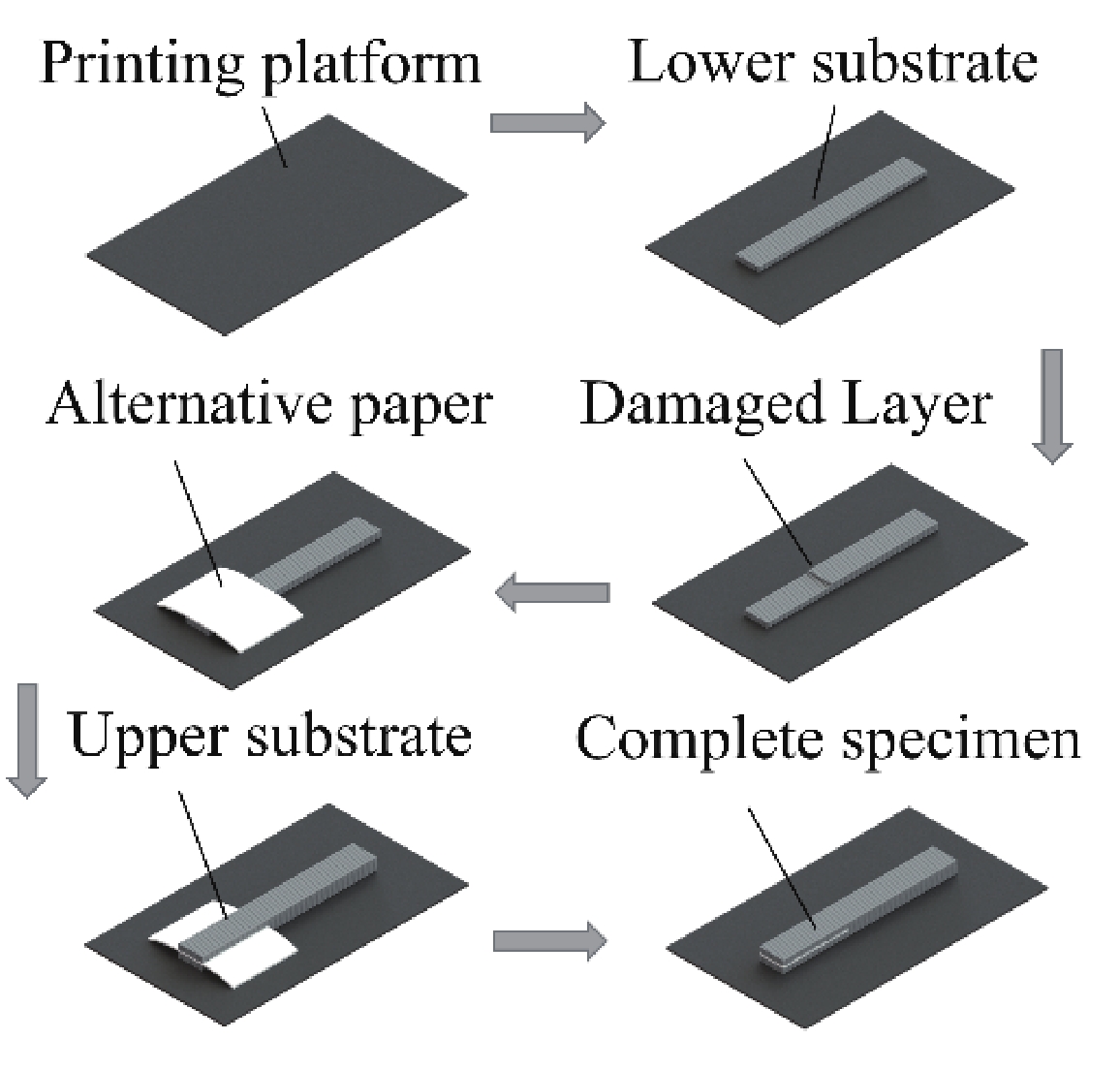
增材制造CFRP荷载-位移曲线仿真结果与试验数据对比分析
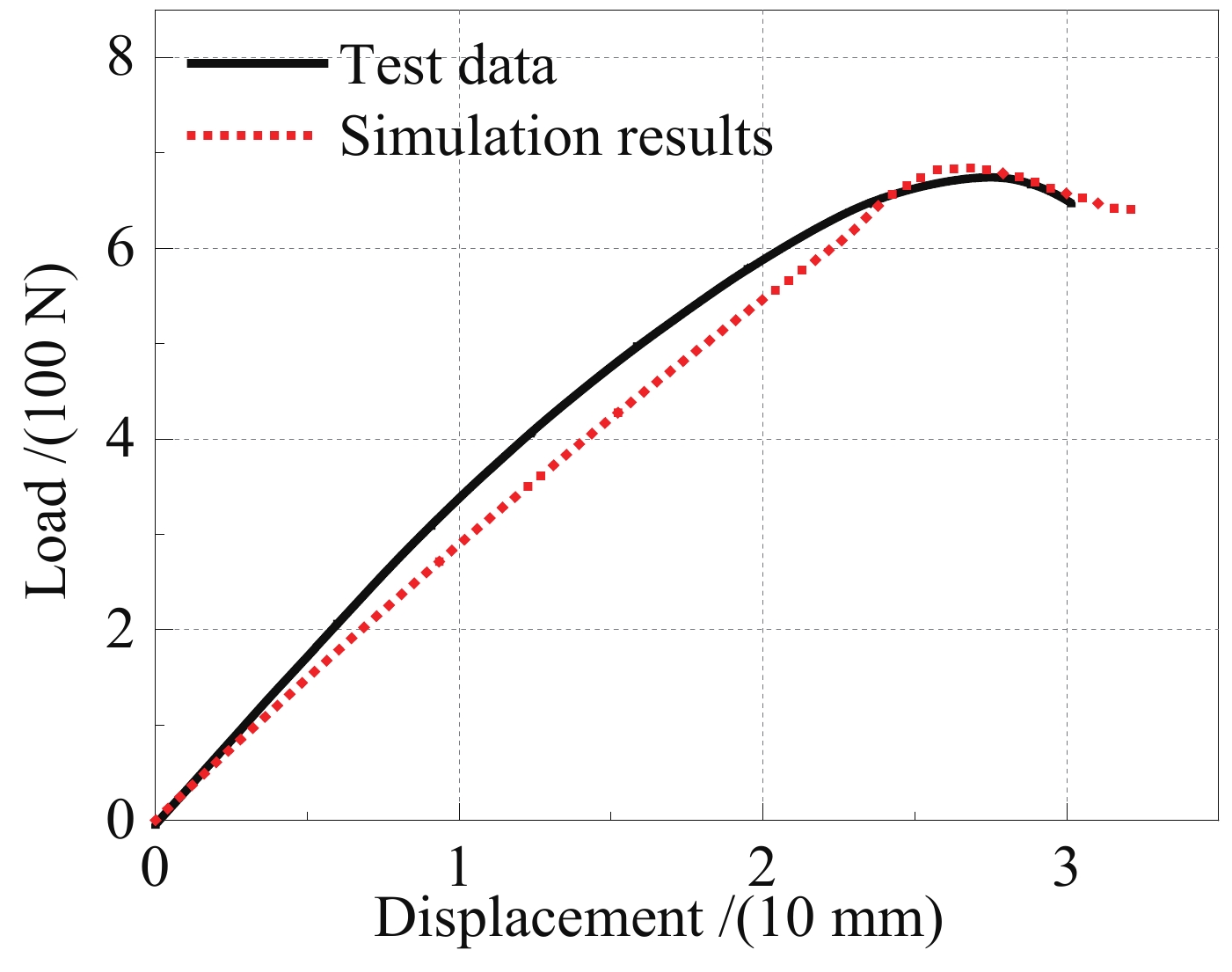




 下载:
下载:
